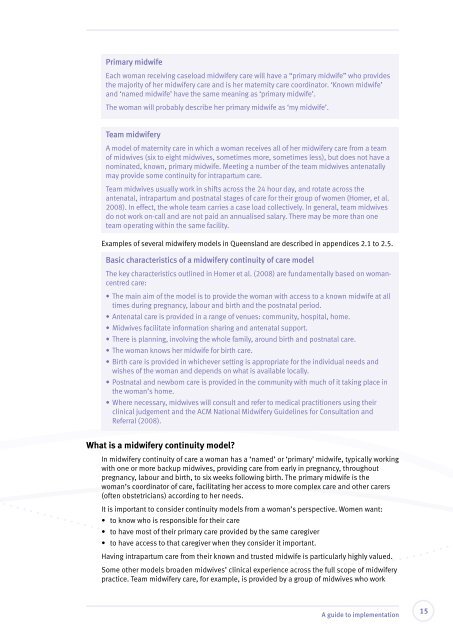Delivering continuity of midwifery care to Queensland women
Delivering continuity of midwifery care to Queensland women
Delivering continuity of midwifery care to Queensland women
You also want an ePaper? Increase the reach of your titles
YUMPU automatically turns print PDFs into web optimized ePapers that Google loves.
Primary midwife<br />
Each woman receiving caseload <strong>midwifery</strong> <strong>care</strong> will have a “primary midwife” who provides<br />
the majority <strong>of</strong> her <strong>midwifery</strong> <strong>care</strong> and is her maternity <strong>care</strong> coordina<strong>to</strong>r. ‘Known midwife’<br />
and ‘named midwife’ have the same meaning as ‘primary midwife’.<br />
The woman will probably describe her primary midwife as ‘my midwife’.<br />
Team <strong>midwifery</strong><br />
A model <strong>of</strong> maternity <strong>care</strong> in which a woman receives all <strong>of</strong> her <strong>midwifery</strong> <strong>care</strong> from a team<br />
<strong>of</strong> midwives (six <strong>to</strong> eight midwives, sometimes more, sometimes less), but does not have a<br />
nominated, known, primary midwife. Meeting a number <strong>of</strong> the team midwives antenatally<br />
may provide some <strong>continuity</strong> for intrapartum <strong>care</strong>.<br />
Team midwives usually work in shifts across the 24 hour day, and rotate across the<br />
antenatal, intrapartum and postnatal stages <strong>of</strong> <strong>care</strong> for their group <strong>of</strong> <strong>women</strong> (Homer, et al.<br />
2008). In effect, the whole team carries a case load collectively. In general, team midwives<br />
do not work on-call and are not paid an annualised salary. There may be more than one<br />
team operating within the same facility.<br />
Examples <strong>of</strong> several <strong>midwifery</strong> models in <strong>Queensland</strong> are described in appendices 2.1 <strong>to</strong> 2.5.<br />
Basic characteristics <strong>of</strong> a <strong>midwifery</strong> <strong>continuity</strong> <strong>of</strong> <strong>care</strong> model<br />
The key characteristics outlined in Homer et al. (2008) are fundamentally based on womancentred<br />
<strong>care</strong>:<br />
• The main aim <strong>of</strong> the model is <strong>to</strong> provide the woman with access <strong>to</strong> a known midwife at all<br />
times during pregnancy, labour and birth and the postnatal period.<br />
• Antenatal <strong>care</strong> is provided in a range <strong>of</strong> venues: community, hospital, home.<br />
• Midwives facilitate information sharing and antenatal support.<br />
• There is planning, involving the whole family, around birth and postnatal <strong>care</strong>.<br />
• The woman knows her midwife for birth <strong>care</strong>.<br />
• Birth <strong>care</strong> is provided in whichever setting is appropriate for the individual needs and<br />
wishes <strong>of</strong> the woman and depends on what is available locally.<br />
• Postnatal and newborn <strong>care</strong> is provided in the community with much <strong>of</strong> it taking place in<br />
the woman’s home.<br />
• Where necessary, midwives will consult and refer <strong>to</strong> medical practitioners using their<br />
clinical judgement and the ACM National Midwifery Guidelines for Consultation and<br />
Referral (2008).<br />
What is a <strong>midwifery</strong> <strong>continuity</strong> model<br />
In <strong>midwifery</strong> <strong>continuity</strong> <strong>of</strong> <strong>care</strong> a woman has a ‘named’ or ‘primary’ midwife, typically working<br />
with one or more backup midwives, providing <strong>care</strong> from early in pregnancy, throughout<br />
pregnancy, labour and birth, <strong>to</strong> six weeks following birth. The primary midwife is the<br />
woman’s coordina<strong>to</strong>r <strong>of</strong> <strong>care</strong>, facilitating her access <strong>to</strong> more complex <strong>care</strong> and other <strong>care</strong>rs<br />
(<strong>of</strong>ten obstetricians) according <strong>to</strong> her needs.<br />
It is important <strong>to</strong> consider <strong>continuity</strong> models from a woman’s perspective. Women want:<br />
• <strong>to</strong> know who is responsible for their <strong>care</strong><br />
• <strong>to</strong> have most <strong>of</strong> their primary <strong>care</strong> provided by the same <strong>care</strong>giver<br />
• <strong>to</strong> have access <strong>to</strong> that <strong>care</strong>giver when they consider it important.<br />
Having intrapartum <strong>care</strong> from their known and trusted midwife is particularly highly valued.<br />
Some other models broaden midwives’ clinical experience across the full scope <strong>of</strong> <strong>midwifery</strong><br />
practice. Team <strong>midwifery</strong> <strong>care</strong>, for example, is provided by a group <strong>of</strong> midwives who work<br />
A guide <strong>to</strong> implementation<br />
15
















